
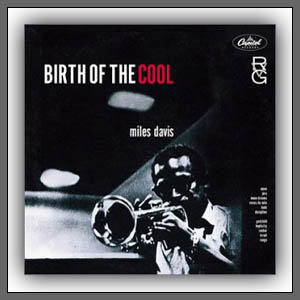
track 1. MOVE:
trumpet - MILES DAVIS
in New York
track 2. JERU:
trumpet - MILES DAVIS
in New York
track 3. MOON DREAMS:
trumpet - MILES DAVIS
in New York
track 4. VENUS DE MILO:
trumpet - MILES DAVIS
in New York
track 5. BUDO:
trumpet - MILES DAVIS
in New York
track 6. DECEPTION:
trumpet - MILES DAVIS
in New York
track 7. GODCHILD:
trumpet - MILES DAVIS
in New York
track 8. BOPLICITY:
trumpet - MILES DAVIS
in New York
track 9. ROCKER:
trumpet - MILES DAVIS
in New York
track 10. ISRAEL:
trumpet - MILES DAVIS
in New York
track 11. ROUGE:
trumpet - MILES DAVIS
in New York
track 12. DARN THAT DREAM:
trumpet - MILES DAVIS
in New York
track 1. MOVE:
trumpet - MILES DAVIS
in New York
track 2. JERU:
trumpet - MILES DAVIS
in New York
track 3. MOON DREAMS:
trumpet - MILES DAVIS
in New York
track 4. VENUS DE MILO:
trumpet - MILES DAVIS
in New York
track 5. BUDO:
trumpet - MILES DAVIS
in New York
track 6. DECEPTION:
trumpet - MILES DAVIS
in New York
track 7. GODCHILD:
trumpet - MILES DAVIS
in New York
track 8. BOPLICITY:
trumpet - MILES DAVIS
in New York
track 9. ROCKER:
trumpet - MILES DAVIS
in New York
track 10. ISRAEL:
trumpet - MILES DAVIS
in New York
track 11. ROUGE:
trumpet - MILES DAVIS
in New York
track 12. DARN THAT DREAM:
trumpet - MILES DAVIS
in New York
OnλinerNotes - JAZZ
|
Birth Of The Cool
CAPITOL
producer - Pete Rugolo |
| Original 1957 LP Liner Notes from Pete Welding:
________In jazz, as in other music, some things are of their time, some ahead of it, while others simply know no time at all. The music produced by the Miles Davis nonet, whose entire recorded output is contained in this album, is all of these and more. Not only was it the product of a specific time and place - and the special grouping of musicians involved in its creation - but it was demonstrably ahead of its time, having influenced a number of _____Many things flowed from this seminal source - subsequent developments in Miles Davis's (bio) own music and in those of various of its participants, notably Gerry Mulligan, Gil Evans (bio) and John Lewis; much small group jazz of the '50s and '60s which drew upon various of its elements as well as its underlying philosophy; the whole West Coast jazz movement, and so on. All of which is even more remarkable when one considers how little the nonet recorded or, more important, performed in public. (The latter generally is the best indication of how musical advances are perceived and received by the listening public.) _____Still, while jazz audiences of the late 1940s may have been indifferent to the music of the nonet, at least to the extent of supporting its New York club dates, jazz players of the time evinced no such resistance but, rather, were quick to recognize the beauty and creative audacity of its music, the quietly revolutionary character of its approach to the small jazz ensemble, and the potential for further development implicit in it. Musicians in fact were the first to respond to what was signaled in the nonet's recordings, and they did so almost immediately. Within two years of the groups final recording session Gerry Mulligan had incorporated various of the nonet's musical receipts in the formation of his celebrated pianoless quartet with Chet Baker and was enjoying great success. Trumpeter-arranger Shorty Rogers assimilated its lessons, first into the arrangements he was doing for the Stan Kenton Orchestra and, from 1951 on, even more fully for his small group The Giants from which so much that was viable in the then emerging West Coast jazz idiom took its lead. John Lewis, another nonet member, had formed and set the musical direction for the Modern Jazz Quartet based largely on his experiences with the Miles Davis group. _____Throughout jazz, in fact, the most forward-looking younger musicians studied the nonet's recordings with the closest interest and translated whatever they could to their own music. Nor did its influence end with these and like activities of the '50s, but in the four decades that have elapsed since the nonet made its first recordings, it has colored the very fabric of small group and through the further collaborations of Miles Davis and Gil Evans which grew from their work for the nonet, orchestral jazz as well. Hindsight has shown, and only too clearly, that these are among the landmark recordings of modern jazz, the implications of which continue to resonate in ways large and small through the music even today. _____While it would be stretching the truth to say that the Miles Davis nonet came about through happenstance, there was a certain amount of the fortuitous to it. And like many things labeled revolutionary after the fact, the nonets music actually evolved gradually, through a steady process of development and experimentation in which its approach was defined, refined and given final shape. _____Its beginnings can be traced to the small group of musicians who from mid-1947 on had taken to gathering at the New York apartment of veteran arranger Gil Evans _____At the time a member of the Charlie Parker Quintet, Miles Davis was directly involved in shaping some of the concepts Gil Evans and his circle were investigating in their periodic sessions. While the experience was of inestimable value to the trumpeter's musical development, the challenges posed by performing nightly alongside such a brilliant, prodigiously inventive soloist as Charlie Parker ultimately proved somewhat daunting, perhaps even frustrating to the younger musician. Then too, Miles Davis was chafing at the relatively simple arrangements and playing formats used in most small bop groups, such as Charlie Parker's which struck the trumpeter as being limited when contrasted with the potentialities suggested by the music itself. He had been drawn to Gil Evans' unorthodox writing for the Claude Thornhill band as a possible alternative to conventional ensemble arrangements. _____The two met when Gil Evans approached Miles Davis with a request to allow him to arrange the latter's "Donna Lee" for Claude Thornhill. Miles Davis asked that he be permitted to study Gil Evans' charts and thus was brought into the arranger's circle. This took place towards the end of 1947, as the Claude Thornhill band recorded "Donna Lee" in November of that year. It was not long before the trumpeter, as Gerry Mulligan recalled, took the initiative, and put the theories to work. _____In its music the nonet sought to realize a number of interlocking goals. Foremost of these was the development of an approach to ensemble writing that would retain the freshness and immediacy of improvised music and in which would be fused elements from bop and Charlie Parker's music in particular, with a number of jazz practices such as a light, vibratoless tonality and a more subtle approach to rhythm that the boppers largely had eschewed, as well as an attempt at achieving the broadened coloristic and textural palette of the large orchestra while using a relatively small number of instruments. A corollary goal was the production of a balanced, more seamless integration between the music's written and improvised elements than was characteristic of bop; the arrangement in effect leading and anchoring the soloist who was, in turn, expected to return his improvisation and resolve it in reference to the written segment that followed. _____Rehearsals took place through much of the ensuing year during which it experimented with varying instrumental combinations from the pool of players available; the core group from Gil Evans's circle occasionally supplemented by friends and associates. A number were drawn from the ranks of the Thornhill Orchestra, at least when it wasn't touring - alto saxophonist Lee Konitz, clarinetist Danny Polo, French horn player Sandy Siegelstein, bassist Joe Shulman, tuba player Bill Barber, drummer Billy Exiner and even arranger George Russell - while other players came from several of the bop groups then active in the city - trombonist J.J. Johnson, pianists John Lewis and Al Haig, bassists Nelson Boyd and Al McKibbon, and drummers Max Roach and Kenny Clarke. As a result of these experiments, it was determined that a basic instrumentation of six horns and three rhythm - trumpet, trombone, French horn, tuba, alto and baritone saxophones, piano, bass and drums - provided the fullest potentials for expressing the range of tonal colors desired. And it was for the grouping that arrangements soon were being devised. _____In September of 1948 Monte Kay secured the group its first playing engagement, a two week stand at The Royal Roost where it alternated with the Count Basie Orchestra. _____Fortunately for us, however, Miles Davis had managed to secure a contract with Capitol Records for which he was engaged to record twelve sides. This in itself was something of a small miracle for as it turns out there was no great enthusiasm for the nonet's music among Capitol's recording executives at the time. The firm's three chief staff producers, Lee Gillette; Voyule Gilmore and Dave Dexter, the latter an avowed jazz aficionado, not only failed to recognize its innovative character, but were wholly indifferent to it, not surprising given their predilection for big bands, Swing and popular jazz-inflected vocalists such as Frank Sinatra, Peggy Lee and Nat Cole. None was interested or actively involved in modern jazz developments such as bop, its offshoots or later developments - at least to the extent of recording them. _____What is surprising is that the nonet was recorded at all. Credit for this falls to Walter Rivers, a relative of songwriter and Capitol Records co-founder Johnny Mercer who was briefly employed by the label during the late 1940s and early '50s. It was Walter Rivers who, based in Capitol's New York offices, arranged for and supervised the nonet's recordings. And for this we are in his debt. _____Several years after they had been released as singles, eight of the nonet's recordings were collected onto a 10" LP (H-459) as part of Capitol's "Classics In Jazz" album series. Three years later, in February of 1957, with the addition of the tracks "Move", "Budo" and "Boplicity" omitted from the earlier album, all 11 of the nonet's instrumental performances were released on a 12" LP (T-762) under the title by which they've been known every since - "The Birth Of The Cool". The title apparently was coined by Pete Rugolo. _____Let's reaffirm something here: catchy album title notwithstanding, the music of the Miles Davis nonet was, is anything but cool. Controlled, lucid, tightly focused, succinct, yes. It's all these and more, but cool in the sense of being dispassionate or otherwise lacking in the fundamental emotional character one always associates with the best jazz, no! As anyone familiar with the nonet's music can attest, it possesses an abundance of focused emotional power all the more effective for being so low-keyed, so apparently subdued in character. _____This resulted directly from Miles Davis' and Gil Evans' desire not only for a lighter textured and rhythmically subtle music but for one possessing a total coherence of design among all its elements - presentation of its thematic materials and development of their implications through the ordered succession of written and improvised parts in interestingly nuanced arrangements devised by their writers for a specific grouping of players whose capabilities and special qualities were, well-known to them. In this they succeeded brilliantly. Among these 12 performances is to be found some, of the most arresting, resourceful, richly textured and abidingly creative small-ensemble writing in all of jazz history as well as an abundance of powerful, focused, assured soloing, much of it of classic stature. _____Chief of the soloists was leader Miles Davis himself who, in Martin Williams' estimation of these recordings, "...was finding a superb and individual solo voice, partly by acknowledging his technical limitations and working within them, and also through an ability to imply bop rhythms in his time without stating them directly; _____Still, excellence of the solos notwithstanding, what most distinguishes the work of the nonet is the meaningful form achieved in its music, the result of the thoughtful, disciplined integration of the written and the improvised, the prearranged and the spontaneous. The balance struck and maintained between these sometimes opposing forces, and the poised, artful ways in which it was brought about are tributes to the sensitivity of the music's arrangers. Five of those involved with the nonet are represented in the recordings made for Capitol. With four of the total 12, pride of place falls to Gerry Mulligan who was responsible for "Godchild", a George Wallington composition, the originals "Venus De Milo" and "Rocker", and the ballad "Darn That Dream", a feature for vocalist Kenny Hagood. Pianist John Lewis arranged "Move" a piece written by drummer Denzil Best when he was a member of the George Shearing Quintet, Miles Davis' and Bud Powell's "Budo" (also recorded by Bud Powell as "Hallucinations"), and the original "Rouge". Johnny Carisi orchestrated his own original blues "Israel", as did Miles Davis on his "Deception". Gil Evans is responsible for "Boplicity", a piece he and Miles Davis had composed (and for which Gil Evans had taken the name of the trumpeter's mother, Cleo Henry, as a writing pseudonym) and the languid "Moon Dreams". _____There can be little doubt that the Miles Davis nonet, through the example of its disciplined, lucid, quietly audacious music, introduced to jazz a refreshing new musical sensibility which helped set it on a new course of development. The implications of the approach signaled in its recordings have carried jazz through several decades of sustained growth and creative discovery, influenced countless groups, musicians and arrangers and altered the very fabric of the music itself. Nor can it be assumed that even after 40 years its influence is ended or its potentialities for further elaboration exhausted. Every generation of musicians since its time has been stimulated, enriched by and found ample food for thought in its music, nor is this likely to change much in coming years. This music, which breathes the spirit and dedication of all involved in its creation, has touched and transfigured all who have heard it and will continue to do so long into the future. (...original 1957 liner notes from Pete Welding...)
_____During the early 1950s Miles Davis struggled with heroin, releasing a series of erratic "hard bop" albums which varied from solid to highly disappointing. By 1955 he had quit the drug, signed to Columbia, and launched a comeback with an appearance at the Newport Jazz Festival. Forming a new quintet with saxophonist John Coltrane, Davis released several classic albums during the mid-'50s before the group broke apart. He then went on to collaborate with Gil Evans on several albums in which he experimented with flugelhorn in addition to trumpet before forming a new sextet in 1958 with John Coltrane (tenor sax), Cannonball Adderley (alto sax), Bill Evans (piano), Paul Chambers (bass) and Philly Joe Jones (drums). This group became Davis's classic backing band, recording groundbreaking albums such as 1958's "Milestones" and 1959's "Kind of Blue", which introduced modal improvisation to jazz. _____In 1975 Miles Davis, in poor health due to years of drug and alcohol abuse, abruptly announced his retirement. Six years later he returned with a new band whose funky pop arrangements continued to alienate critics while winning over new fans. Throughout the '80s Davis toured and recorded, finally passing away in September 1991 at the age of 65, leaving behind a huge body of work which left a permanent mark on the world of jazz and music in general and continues to captivate listeners to this day. (...from Down Beat
_____One of the most significant arrangers in jazz history, Gil Evans' three album-length collaborations with Miles Davis _____Like Miles Davis, Gil Evans became involved in utilizing electronics in the 1970s and preferred not to look back and recreate the past. He led his own band in California (1933-38) which eventually became the backup group for Skinnay Ennis; Gil Evans stayed on for a time as arranger. He gained recognition for his somewhat futuristic charts for Claude Thornhill's Orchestra (1941-42 and 1946-48) which took advantage of the ensemble's cool tones, utilized French horns and a tuba as frontline instruments and by 1946 incorporated the influence of bop. He met Miles Davis (who admired his work with Claude Thornhill) during this time and contributed arrangements of "Moon Dreams" and "Boplicity" to Miles Davis' "Birth of the Cool" nonet. _____After a period in obscurity, Gil Evans wrote for a Helen Merrill session and then collaborated with Miles Davis on "Miles Ahead". In addition to his work with Miles Davis (which also included a 1961 recorded Carnegie Hall concert and the half-album "Quiet Nights"), Gil Evans recorded several superb and highly original sets as a leader (including "Gil Evans and Ten", "New Bottle Old Wine" and "Great Jazz Standards") during the era. _____In the 1960s among the albums he worked on for other artists were notable efforts with Kenny Burrell and Astrud Gilberto. After his own sessions for Verve® during 1963-64, Gil Evans waited until 1969 until recording again as a leader.
| |
|
OnλinerNotes - JAZZ | |
|
|
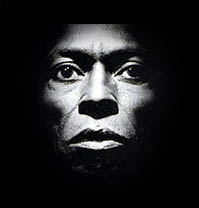
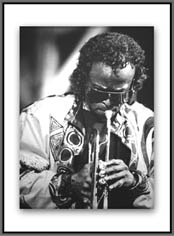 jazz developments that followed and took their lead from it. Then too, as listening will make immediately apparent, it's also timeless, as most perfect things are.
jazz developments that followed and took their lead from it. Then too, as listening will make immediately apparent, it's also timeless, as most perfect things are.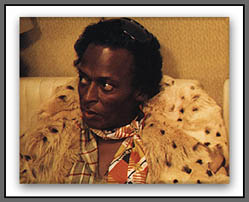 He called the rehearsals, hired the halls, called the players, and generally cracked the whip. Under Miles Davis' catalyzing influence the informal discussions and ad hoc sessions soon developed into something quite different and ideas that until then had been little more than vague theoretical possibilities soon were being tested and were taking shape in the crucible of regular rehearsals.
He called the rehearsals, hired the halls, called the players, and generally cracked the whip. Under Miles Davis' catalyzing influence the informal discussions and ad hoc sessions soon developed into something quite different and ideas that until then had been little more than vague theoretical possibilities soon were being tested and were taking shape in the crucible of regular rehearsals.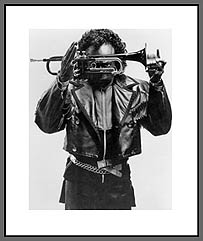 Personnel for this date comprised of Miles Davis; trombonist Mike Zwerin; Junior Collins, French horn; Bill Barber; Lee Konitz; Gerry Mulligan; John Lewis; Al McKibbon; Max Roach and vocalist Kenny Hagood. Reaction to its music was at best mixed. While a number of critics and musicians, Count Basie included, reacted with great enthusiasm, club patrons largely were indifferent to the nonet's experiments. The group did not perform in public again until the following year when it played a brief engagement at The Clique Club.
Personnel for this date comprised of Miles Davis; trombonist Mike Zwerin; Junior Collins, French horn; Bill Barber; Lee Konitz; Gerry Mulligan; John Lewis; Al McKibbon; Max Roach and vocalist Kenny Hagood. Reaction to its music was at best mixed. While a number of critics and musicians, Count Basie included, reacted with great enthusiasm, club patrons largely were indifferent to the nonet's experiments. The group did not perform in public again until the following year when it played a brief engagement at The Clique Club.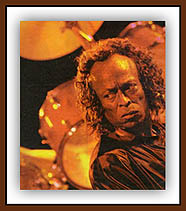 Lee Konitz was breaking away from the rigid lessons of his teacher, (Lennie) Tristano; and J.J. Johnson was continuing to show himself an exceptional and inventive instrumentalist..." He concluded, "...by themselves, the solos on these recordings might make them classics..."
Lee Konitz was breaking away from the rigid lessons of his teacher, (Lennie) Tristano; and J.J. Johnson was continuing to show himself an exceptional and inventive instrumentalist..." He concluded, "...by themselves, the solos on these recordings might make them classics..."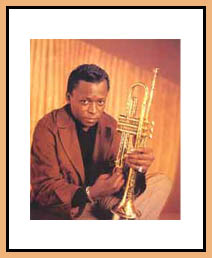 age of 10 Davis was playing trumpet, later performing in his high school band and several local jazz groups. When he was 18, Davis traveled to New York to study at the Julliard School of Music, but soon dropped out to hang out in the city's burgeoning jazz scene. Getting his start with Coleman Hawkins and Rubberlegs Williams, Davis soon joined Charlie Parker on several of late '40s albums in New York and California. In 1948 Davis started his own nine-pieceband, a highly-influential group considered a pioneering force in West Coast "cool jazz." After recording the 1949 classic "Birth of the Cool", Davis left the band (which continued on without him) to perform at the Paris Jazz Festival and work with other musicians.
age of 10 Davis was playing trumpet, later performing in his high school band and several local jazz groups. When he was 18, Davis traveled to New York to study at the Julliard School of Music, but soon dropped out to hang out in the city's burgeoning jazz scene. Getting his start with Coleman Hawkins and Rubberlegs Williams, Davis soon joined Charlie Parker on several of late '40s albums in New York and California. In 1948 Davis started his own nine-pieceband, a highly-influential group considered a pioneering force in West Coast "cool jazz." After recording the 1949 classic "Birth of the Cool", Davis left the band (which continued on without him) to perform at the Paris Jazz Festival and work with other musicians.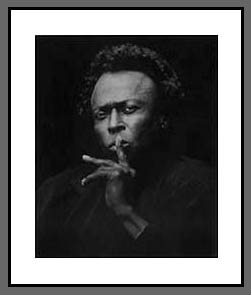 _____The group slowly drifted apart during the early '60s. In 1964 Davis formed a new, more experimental quintet, featuring pianist Herbie Hancock, among others. The group slowly changed as members came and went, drifting from more traditional jazz to avant-garde material and later funky, keyboard-driven fusion, embodied by the 1969 jazz-rock masterpiece "Bitches Brew". During the early '70s Davis's output tended towards more accessible, jazz-rock material whose guitars, keyboards and studio effects turned off many jazz critics and traditionalists.
_____The group slowly drifted apart during the early '60s. In 1964 Davis formed a new, more experimental quintet, featuring pianist Herbie Hancock, among others. The group slowly changed as members came and went, drifting from more traditional jazz to avant-garde material and later funky, keyboard-driven fusion, embodied by the 1969 jazz-rock masterpiece "Bitches Brew". During the early '70s Davis's output tended towards more accessible, jazz-rock material whose guitars, keyboards and studio effects turned off many jazz critics and traditionalists.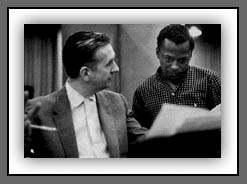 ("Miles Ahead", "Porgy and Bess" and "Sketches of Spain") are all considered classics. Gil Evans had a lengthy and wide-ranging career that sometimes ran parallel to the trumpeter.
("Miles Ahead", "Porgy and Bess" and "Sketches of Spain") are all considered classics. Gil Evans had a lengthy and wide-ranging career that sometimes ran parallel to the trumpeter.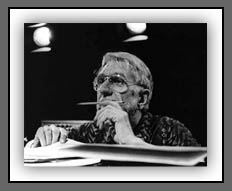 That year's "Blues in Orbit" was his first successful effort at combining acoustic and electric instruments; it would be followed by dates for Artists House®, Atlantic® (Svengali®) and a notable tribute to Jimi Hendrix in 1974. After 1975's "There Comes a Time" (which features among its sidemen David Sanborn), most of Gil Evans' recordings were taken from live performances. Starting in 1970 he began playing with his large ensemble on a weekly basis in New York clubs. Filled with such all-star players as George Adams, Lew Soloff, Marvin "Hannibal" Peterson, Chris Hunter, Howard Johnson, Pete Levin, Hiram Bullock, Hamiet Bluiett and Arthur Blythe among others, Gil Evans' later bands were top-heavy in talent but tended to ramble on too long. Gil Evans, other than sketching out a framework and contributing his keyboard, seemed to let the orchestra largely run itself, inspiring rather than closely directing the music. There were some worthwhile recordings from the 1980s (when the band had a long string of Monday night gigs at Sweet Basil in New York) but in general they do not often live up to their potential. Prior to his death, Gil Evans recorded with his "arranger's piano" on duets with Lee Konitz and Steve Lacy and his body of work on a whole ranks with the top jazz arrangers. (...from
That year's "Blues in Orbit" was his first successful effort at combining acoustic and electric instruments; it would be followed by dates for Artists House®, Atlantic® (Svengali®) and a notable tribute to Jimi Hendrix in 1974. After 1975's "There Comes a Time" (which features among its sidemen David Sanborn), most of Gil Evans' recordings were taken from live performances. Starting in 1970 he began playing with his large ensemble on a weekly basis in New York clubs. Filled with such all-star players as George Adams, Lew Soloff, Marvin "Hannibal" Peterson, Chris Hunter, Howard Johnson, Pete Levin, Hiram Bullock, Hamiet Bluiett and Arthur Blythe among others, Gil Evans' later bands were top-heavy in talent but tended to ramble on too long. Gil Evans, other than sketching out a framework and contributing his keyboard, seemed to let the orchestra largely run itself, inspiring rather than closely directing the music. There were some worthwhile recordings from the 1980s (when the band had a long string of Monday night gigs at Sweet Basil in New York) but in general they do not often live up to their potential. Prior to his death, Gil Evans recorded with his "arranger's piano" on duets with Lee Konitz and Steve Lacy and his body of work on a whole ranks with the top jazz arrangers. (...from